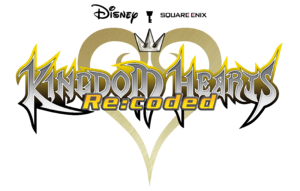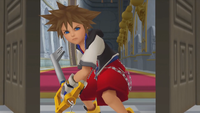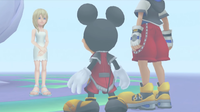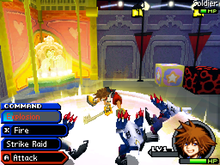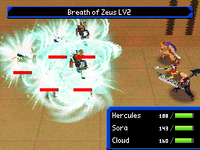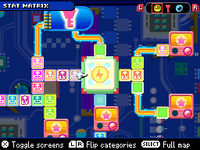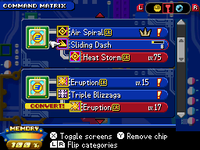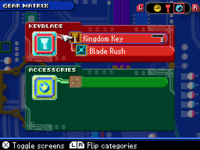Kingdom Hearts Re:coded
| Kingdom Hearts Re:coded | |
|---|---|
| キングダムハーツ Re:コーデッド Kingudamu Hātsu Re: kōdeddo | |
| Developer(s) | Square Enix h.a.n.d. Inc. |
| Publisher(s) | Square Enix |
| Release date(s) | |
| Genre | Console action role-playing game |
| Game modes | |
| Ratings | CERO: A ESRB: E10+ PEGI: 12+ USK: 6+ OFLC: |
| Platform(s) | Nintendo DS |
- "It's a PLAY-full world!"
- —Tagline
Kingdom Hearts Re:coded is a full remake of Kingdom Hearts coded released on the Nintendo DS. Like Kingdom Hearts Re:Chain of Memories, there are many additions to the game from the original, including adjustable difficulty settings, multiplayer elements, and the addition of a new secret movie.
The game takes place after the events of Kingdom Hearts II, but before the epilogue of Kingdom Hearts II where the bottled letter is read on Destiny Islands. Kingdom Hearts Re:coded follows the story of Jiminy Cricket, King Mickey, Donald Duck, and Goofy in Disney Castle as they monitor the progress of a Data-Sora in a digital world.
It was released on October 7, 2010 in Japan, on January 11, 2011 in North America,[2] and on January 14, 2011 in Europe,[3] making Kingdom Hearts Re:coded the second Kingdom Hearts remake with a release outside of Japan and North America, the first one being Kingdom Hearts Re:Chain of Memories.
The game was re-released in Japan on March 29, 2012, as part of the Kingdom Hearts 10th Anniversary Box. The game was remade as an HD movie for Kingdom Hearts HD 2.5 ReMIX with a few additional cutscenes.
Story
While organizing the records in Jiminy's Journal from his travels with Sora and his friends, Jiminy's curiosity about the line "Thank Naminé" results in him finding a message that he did not write: "Their hurting will be mended when you return to end it." To investigate this message, King Mickey digitizes the contents of the journal and sends a virtual Data-Sora on the virtual Destiny Islands to carry out the contents of the journal to uncover the identity of those who are "hurting".
As Data-Sora awakens on Destiny Islands, he encounters numerous "bugs", which take the form of red and black blocks, covering the whole world. Upon eliminating the Heartless and destroying the bugs, Data-Sora traverses to other worlds infected with bugs to return them to normal, following the cloaked figure upon orders from King Mickey.
Meanwhile, Heartless begin appearing within Disney Castle, and everyone finds themselves trapped in the room. To their surprise, they are saved by Data-Sora. Suddenly, the cloaked figure reveals himself to be Jiminy's Journal taking the form of Riku, and explains that they are no longer in the real world, but the Data World. Suddenly, they discovered that someone cut the link to the real world and the only way to repair it is too destroy the bugs. Sora is sent off by the Journal to discover the one responsible, and encounters Maleficent and Pete from the real world. Maleficent destroys Data-Sora's Keyblade and summons Heartless to attack him. Mickey and the Journal arrive to save Data-Sora, but the Journal is abducted by Maleficent, with Mickey giving chase. Data-Sora makes his way through Hollow Bastion, aided by Donald and Goofy. They encounter Pete, who summons the Journal and takes control of him with the bugs to fight them, but Data-Sora regains the Keyblade and managed to defeat the Journal, who falls unconscious.
Mickey arrives and informs Data-Sora that unless the bugs are destroyed, the Journal will never awaken. Data-Sora decides to find a way to awaken the Journal, and enters Data-Riku's Data World, losing his abilities in the process. The two visit various worlds from the Data-Riku's memory and find their way back to Hollow Bastion, where they fight and defeat Maleficent. Meanwhile, King Mickey discovers that he will be returning soon to the real world, but the Journal, once completed, will have to be erased, which will mean the end of Data-Sora's memories. When the time comes, Sora requests more time in order to save Pete and Maleficent, who are still in the Data World. Data-Sora finds them fighting Sora's Heartless, but Pete and Maleficent are seemingly erased before he can intervene. Data-Sora defeats Sora's Heartless, and finds that Pete and Maleficent were rescued by the Journal through a "rift in the data".
Following their defeat, Maleficent and Pete decide to pursue the ancient Book of Prophecies, which they believe to be connected to Jiminy's Journal and the Datascape. They leave the Data World shortly before Mickey returns to the real world, erasing the Journal. A new message appears claiming that a new door to a new world has been opened, which is the data of the Data World added into the Journal. Mickey, realizing that this quest may be too dangerous for Data-Sora as he has no memory of it, requests to be taken into the Data World once again.
Finding Data-Sora in Traverse Town, Mickey takes him to Castle Oblivion where Data-Sora is confronted by a young man wearing a black coat. He tells Data-Sora that if he wants to know the truth, he must move forward on his own through the previous worlds he visited destroying bugs. During this time, he realizes that even if he doesn't remember someone he's met, there's still the sadness of having forgotten them which the figure attempts to warn not to let it consume him. Data-Sora disregards this message and fights the figure, revealed to be Data-Roxas. After losing, Data-Roxas gives him a card as Mickey appears.
Data-Sora opens the next door to find Data-Naminé, who reveals the bugs to have been an unintentional side effect of her attempt to restore Sora's memories. She then reveals Sora's nature as the "Key that connects everything" through his ties with herself, Roxas, Axel, and Xion. Furthermore, Data-Naminé tells Data-Sora about three figures (Terra, Ventus, and Aqua) also tied to Sora's heart who are the ones referred to in the message and need his help. Mickey bids farewell to Data-Sora and promises Data-Naminé that he will inform the real Sora of this.
Mickey promptly sends Sora a bottled letter (as seen in Kingdom Hearts II). Back at Destiny Islands, Sora takes the parchment out of the bottle, and reads Mickey's message with Riku and Kairi.
Signs of What's Next
Sometime later, Mickey is shown in the Mysterious Tower, informing Yen Sid that they are close to locating Ventus's heart and have only to find Terra. However, Yen Sid delivers the shocking news that Xehanort has been revived due to the destruction of both Ansem and Xemnas at the hands of Sora, which will ultimately lead to Master Xehanort's revival. Realizing that not just a "single" Xehanort has returned, Yen Sid orders Mickey to summon Sora and Riku before him to undertake a Mark of Mastery exam in order to become full-fledged Keyblade Masters for their imminent clash with Master Xehanort. Signs of What's Next
Gameplay
The gameplay in Kingdom Hearts Re:coded is largely the same as in Kingdom Hearts coded, focusing on the manipulation of Bug Blox to solve puzzles and reach new areas, but also incorporates the Deck Command system used in Kingdom Hearts Birth by Sleep, which allows players to design "decks" of various combat abilities to use against enemies. Kingdom Hearts Re:coded appears to use the same game engine employed in Kingdom Hearts 358/2 Days, the previous DS game in the series.
Command Deck
Kingdom Hearts Re:coded uses a Command Deck-like combat system. Sora attacks with normal strikes of the Keyblade with ![]() , while using special commands like Strike Raid and Fire with
, while using special commands like Strike Raid and Fire with ![]() . Tap
. Tap ![]() to scroll through Sora deck of commands. Hold in
to scroll through Sora deck of commands. Hold in ![]() and press
and press ![]() or
or ![]() to navigate the deck up and down (respectively), or press
to navigate the deck up and down (respectively), or press ![]() and
and ![]() buttons simultaneously to use the command set as a shortcut, regardless of whether it is currently selected in the Command Deck. Sora can also perform series staples such as Dodge Roll and Reflect Guard with
buttons simultaneously to use the command set as a shortcut, regardless of whether it is currently selected in the Command Deck. Sora can also perform series staples such as Dodge Roll and Reflect Guard with ![]() .
.
Clock Program & Passive Abilities
As Sora damages enemies or destroys blocks with either commands or regular attacks, the Clock gauge will fill. When completely filled, the gauge will "level up," granting Sora a passive ability known as Clock abilities. By continuing to fill (or "Overclock") the gauge, it can reach the "MAX Clock," which allows Sora to unleash a powerful finishing strike against enemies with the Attack command, which glows orange when ready for use. Afterwards, the Clock gauge will reset. The touchscreen shows the Clock tree, a branching grid of the passive abilities that will be gained. The stylus can be used to tap a passive ability of the next level, altering the path and changing the passive ability Sora will gain. Some abilities have an 'x' after them, indicating that that ability is the last in that branch. The abilities available are unique and dependent on the Keyblade equipped, and each upgrade of a Keyblade reveals a new ability.
Data Worlds
As Sora progresses through the worlds in the Datascape, he will seek out System Sectors, areas in each of the worlds' core programming, which contain bugs and corrupted data that cause glitches in the worlds. In these closed-off spaces, Sora is tasked with navigating through a set number of floors, eliminating "bugged" Heartless targets in each. Destroying Bug Blox and defeating Heartless will award Sora with Sector Points (SP). However, being struck by enemy attacks will cost a bit of the accumulated SP. By completing each floor and moving on to the terminal, Sora can cash in his accrued SP for exclusive Accessories and Commands. Any SP remaining can be converted to either Experience or Munny.
Each World also contains special events that feature gameplay styles that differ from the main game, like Traverse Town's side-scrolling platformer stages, Wonderland's rail shooting obstacle course, or the Olympus Coliseum's turn-based party combat, which is similar to the Final Fantasy combat system. Each of these events ends with a grading system based on the Sora's performance therein, which begets special bonus items for achieving outstanding grades.
The Matrix System
Re:coded makes use of a unique system for character growth by using a few subcategories of what is known as a Matrix. Each Matrix deals with an aspect of Sora's character development and status.
Stat Matrix
The Stat Matrix handles Sora's level growth and abilities. Similar to the Final Fantasy X Sphere Grid, Sora progresses on a line of circuitry within the matrix, whose paths are segmented into blocks. Throughout Sora's quest, he'll receive panels like Strength Up or Magic Up that can be placed in those blocks, amplifying the applicable stats, and progressing further through the matrix. At each level up, Sora will also gain a Level Up panel, similar to Kingdom Hearts 358/2 Days, that will grant Sora a boost to all his stats. Scattered all throughout the matrix are ability panels, which when the line of active circuitry connects to one, Sora will gain abilities like Scan, Combo Plus, and Dodge Roll.
Extra slots for Sora's Command deck and more Accessory slots are also acquired through the Stat Matrix. As he progress, the matrix will expand, offering branching paths of circuitry to follow sometimes with beneficial abilities at their ends. If a panel is placed between two CPUs, it will activate "Dual Processing," doubling the power of those panels. It should be noted that any panels placed onto the matrix cannot be removed but can be replaced with another chip, as long as an empty circuit is lit up, a panel can be placed in it, even if it's not a part of the previously expanded circuitry path. The difficulty setting can also be adjusted between Beginner, Standard, Proud, and Critical at any time from the Stat Matrix, as well.
Command Matrix
The Command Matrix is where Sora's combat skills are installed and items to be used in battle. While sharing many similarities with the Kingdom Hearts Birth by Sleep Deck Command system, the Command Matrix allows for mixing and matching commands temporarily. By installing a command, it can then be supplemented with another skill, producing various effects, such as changing a command into its Fire-type version by combining it with a Fire command. When the commands have gained enough experience, they can be permanently fused, allowing the resulting command to increase to a higher level and subsequently be used in further conversions. The Command Matrix also has a "Memory" capacity, which restricts the creation of a deck comprised of high-powered Commands. At the beginning of the game, Sora begins with three Command Slots, but gains more as he progresses through certain circuitry in the Stat Matrix.
Gear Matrix
The Gear Matrix handles Sora's equipment, split into "Keyblade" and "Accessory." Throughout the game, Sora will gain new Keyblades that change the passive abilities he gets through the Overclock programs Leveling system. By continuing to use the same Keyblade, its level will increase, unlocking more of the abilities to access from different branches. When the Clock Gauge is filled to the MAX Level of each branch, the "Attack" command will change into a Finish Command as set in the Keyblade section. Most Finish Commands can be obtained by exchanging SP in certain System Areas while others can be obtained by breaking Rare Prize Blocks or buying from the Moogle Shop. Accessories are equipped in a similar fashion like the rest of the series, with each granting special bonuses to HP percentage or resistance to certain elements, or other benefits. More Accessory Slots can be acquired through progression on the Stat Matrix.
Gallery
External links
- Official NA website
- Official EUR website
- Official JP website
- Official NA website (Nintendo of America)
- Official EUR website (Nintendo UK)
Notes and references
| Kingdom Hearts HD 2.5 ReMIX |
|---|
| Kingdom Hearts II Final Mix • Kingdom Hearts Birth by Sleep Final Mix • Kingdom Hearts Re:coded |
